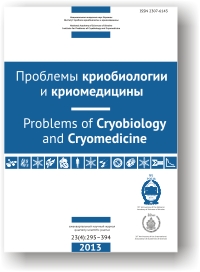СоÑтоÑние вегетативной и гуморальной регулÑции Ñердечного ритма молодых и Ñтарых ÐºÑ€Ñ‹Ñ Ð½Ð° фоне ритмичеÑкого ÑкÑтремального Ð¾Ñ…Ð»Ð°Ð¶Ð´ÐµÐ½Ð¸Ñ (–120°С) в Ñочетании Ñ Ð²Ð²ÐµÐ´ÐµÐ½Ð¸ÐµÐ¼ ÑдроÑодержащих клеток кордовой крови
Ключові слова:
ритмічні екÑтремальні холодові впливи, ÑдровміÑні клітини кордової крові, варіабельніÑÑ‚ÑŒ Ñерцевого ритму, нейрогуморальна регулÑціÑ, кріокамераАнотація
За допомогою Ñпектрального аналізу варіабельноÑÑ‚Ñ– Ñерцевого ритму доÑліджено Ñтан вегетативної та гуморальної регулÑції Ñерцевого ритму в молодих Ñ– Ñтарих щурів піÑÐ»Ñ ÑуміÑного заÑтоÑÑƒÐ²Ð°Ð½Ð½Ñ Ñ€Ð¸Ñ‚Ð¼Ñ–Ñ‡Ð½Ð¸Ñ… екÑтремальних холодових впливів (РЕХВ) Ñ– препарату Ñдерних клітин кордової крові (ЯК КК). Показано позитивний вплив РЕХВ Ñ– ЯК КК на функціональний Ñтан регулÑторних ÑиÑтем організму тварин незалежно від Ñ—Ñ… віку, що підтверджуєтьÑÑ Ð¿Ñ–Ð´Ð²Ð¸Ñ‰ÐµÐ½Ð½Ñм показників загальної Ñпектральної потужноÑÑ‚Ñ– нейрогуморальної регулÑції за рахунок активації вегетативної нервової ÑиÑтеми та гуморальної ланки регулÑції. Отримані дані Ñвідчать про те, що у Ñтарих тварин піÑÐ»Ñ Ð Ð•Ð¥Ð’ Ñ– Ð²Ð²ÐµÐ´ÐµÐ½Ð½Ñ Ð¯Ðš КК Ð¿Ñ€Ð¾Ñ†ÐµÑ ÑƒÐ¿Ñ€Ð°Ð²Ð»Ñ–Ð½Ð½Ñ Ñерцевим ритмом переходить із повільного гуморально-метаболічного Ñ€Ñ–Ð²Ð½Ñ Ñ€ÐµÐ³ÑƒÐ»Ñції на швидкий вегетативний, Ñкий не влаÑтивий літньому організму.Â
Посилання
Aydaraliyev A.A., Maksimov A.L. Human adaptability to extreme conditions. Leningrad: Nauka, 1988.
Babiychuk V.G. Comparative characteristics of cardiac rhythm in rats using different methods of cold exposures. Problems of Cryobiology 2007; 17 (3): 229–236.
Baevsky R.M., Berseneva A.P. Estimation of adaptable opportunities of an organism and risk of diseases development. – Moscow, 1997.
Butenko G.M., Voytenko V.P. Genetic and immunologic mechanisms of age pathology. – Kyiv: Zdorov'ya, 1983.
Voronin I.M., Govsha Yu.A., Istomina T.A., Belov A.M. Variability and spectral analysis of cardiac rhythm in diagnosis of dysfunction of the sinus node. Kardiologiia 1999; (10): 32–34.
Korkushko O.V. Cardiovascular system and age – Moscow: Meditsina, 1983.
Kryzhanovsky G.N. General pathophysiology of nervous system: Handbook. Moscow: Meditsina, 1997.
Matusova A.P. Clinical value of statistical analysis of cardiac rhythm in patients with acute myocardial infarction. Kardiologiya 1989; 29 (1): 29–32.
Smetnev A.S., Zharinov O.I., Chubuchny V.N. Heart rate variability, ventricular arrhythmias and risk of sudden death. Kardiologiia 1995; 34 (4): 49–52.
Frolkis V.V. Syndromes of aging. Vestnik AMN SSSR 1990; (1): 8–13.
Frolkis V.V. Brain aging. – Leningrad: Nauka, 1991.
Shiman A.G., Kiryanova V.V., Maksimova A.V. et al. Clinical and physiological aspects of cryotherapy. Vestnik of North–Western State Medical Academy named after I.I. Mechnikov 2001; (1): 27–34.
Patent N 40168 Ukraine, IPC A61V 18/00. Cryochamber for experimental cooling of laboratory animals / G.O. Babiychuk, O.V. Kozlov, I.I. Lomakin, V.G. Babiychuk; owned by the Institute for Problems of Cryobiology and Cryomedicine of the National Academy of Sciences of Ukraine. – Appl. u200812930 06.11.1998; Publ. 25.03.2009. – Bull. Nr. 6.
Patent N92227 Ukraine IPC Ð01N1/02. Method of cryopreservation of nucleated cells of cord blood including hemopoietic stem cells / L.O. Babiychuk, V.I. Grischenko, T.M. Gurina et al.; Appl. â„–200814009 05.12.2008: Publ.11.10.2010. – Bul. Nr. 19.
Cornetta K., Laughlin M., Carter S. Umbilical cord blood transplantation in adults: results of the prospective Cord Blood Transplantation (COBLT). Biol Blood Marrow Transplant 1995; 2 (11): 149–160.
Gluckman E., Broxmeyer H.A., Auerbach A.D. Hematopoietic reconstitution in a patient with Franconi’s anemia by means of umbilical-cord blood from an HLA-identical sibling. N Engl J Med 1989; 32 (17): 1174–1178.
Long G.D., Laughlin M., Madan B. Unrelated umbilical cord blood transplantation in adult patients. Biol Blood Marrow Transplant 2003; 9(12): 772–780.
Roccanova L., Ramphal P. The role of stem cells in the evolution of longevity and its application to tissue therapy. Tissue Cell 2003; 35(1): 79–81.
Downloads
Опубліковано
Як цитувати
Номер
Розділ
Ліцензія
Авторське право (c) 2020 Yuliya V. Rudneva, Vladislav G. Babiychuk, Elena A. Chernyavskaya, Vladimir V. Kulik

Ця робота ліцензується відповідно до Creative Commons Attribution 4.0 International License.
Автори, які публікуються у цьому журналі, погоджуються з наступними умовами:
- Автори залишають за собою право на авторство своєї роботи та передають журналу право першої публікації цієї роботи на умовах ліцензії Creative Commons Attribution License, котра дозволяє іншим особам вільно розповсюджувати опубліковану роботу з обов'язковим посиланням на авторів оригінальної роботи та першу публікацію роботи у цьому журналі.
- Автори мають право укладати самостійні додаткові угоди щодо неексклюзивного розповсюдження роботи у тому вигляді, в якому вона була опублікована цим журналом (наприклад, розміщувати роботу в електронному сховищі установи або публікувати у складі монографії), за умови збереження посилання на першу публікацію роботи у цьому журналі.
- Політика журналу дозволяє і заохочує розміщення авторами в мережі Інтернет (наприклад, у сховищах установ або на особистих веб-сайтах) рукопису роботи, як до подання цього рукопису до редакції, так і під час його редакційного опрацювання, оскільки це сприяє виникненню продуктивної наукової дискусії та позитивно позначається на оперативності та динаміці цитування опублікованої роботи (див. The Effect of Open Access).




